Garden soil in pots?? Bad idea!
Hey guys, this forum really doesnt need any more information about not putting soil in pots, however I thought I would post this story and picture anyway, showing why it�s a really, really bad idea to use garden soil as a potting mix.
As background information, about a month ago I had a truck deliver some soil from a soil company labeled �composting soil� for a raised vegie garden bed. It is a mix of manure, sand and other unknown ingredients. The plants in my raised bed seem to enjoy it. I had some left over and mixed it throughout other vegie patches I was building, they all loved it too!
I still had some left over, and before reading this forum I decided I would use it to pot up some of my plants! I used a small amount in a curry leaf tree (which seems to be doing alright, as I left the bulk of the potting mix attached in a fairly small pot� whew!) and then after reading this forum thought to myself.. How bad could it REALLY be!?
So I filled half a pot with the mix and then filled it with some water, and sat down to see how quick it drained. After sitting for about 10 minutes with NOTHING coming out the bottom, I thought the holes in the bottom must have been clogged or something, so I got a big sticked and stirred it all about making sure the soil was totally saturated. I waited a bit more and obserbed a very small trickle coming out the bottom.
Anyway 4 days later, there was still a layer of water on top of the soil, despite having several days between 30-34o in a row (86-93F). Then it rained for a day and got filled some more, and then rained again a few days later. Finally this weekend after repotting a bunch of plants into Al�s 5-1-1 mix I went and looked closely at the pot which STILL had water in it, except now it was full of little mosquito wrigglers! Needless to say I then dumped the whole foul mess. The pic is taken right before I dumped it.
Moral of the story, don�t put soil for your garden into pots!!
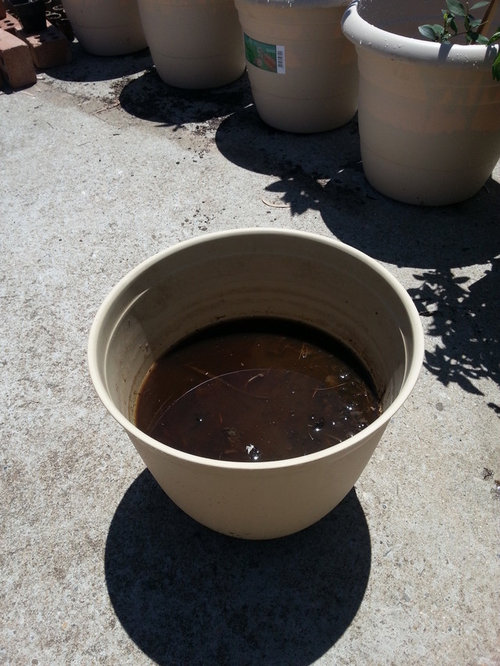
Comments (36)
TheMasterGardener1
11 years agoHere is some cayenne I grew in 100% garden soil. They made some really good cayenne powder....
A few notes I thought I should add:
-You cant really use to large of a container when using topsoil. That is why your pots wont drain.
-When using topsoil it is good to let the soil dry all the way before watering the plant.
-I gave these a few application of miracle gro all purpose fertilizer through out the season.
-The only reason to use topsoil in containers is becauseit is free and most of time has a good ph depending on your native soil. My soil is rich and clay like, but a dark color so there is not much clay and a good amount of organic matter. If you have a 'red' colored type clay soil then you cant use it.
So I would say you can use topsoil in a container. Its not "the best" choice, but that all depends if your after "the best". ;)
{{gwi:2553}}
{{gwi:2552}}This post was edited by TheMasterGardener1 on Mon, Feb 4, 13 at 12:02
nil13
11 years agoIt would be interesting to see what sort of composition people's soil has with this sort of thing. Have either of you run a soil composition test?
Related Professionals
Simpsonville Landscape Architects & Landscape Designers · East Rancho Dominguez Landscape Architects & Landscape Designers · Oconomowoc Landscape Architects & Landscape Designers · Sahuarita Landscape Architects & Landscape Designers · Aurora Landscape Contractors · El Segundo Landscape Contractors · Milton Landscape Contractors · Wilsonville Landscape Contractors · Carson Solar Energy Systems · Maplewood Solar Energy Systems · Arlington Window Contractors · Northbridge Window Contractors · Vashon Window Contractors · Eagle Mountain Fence Contractors · Plainfield Fence Contractorsgreenman28 NorCal 7b/8a
11 years agoNaikii, good observations :-)
As I've said about boggy soils in the past.... "The proof is in the pudding."
That soupy mess is a perfect example of what can happen in a container
when the soil particulate is so fine that it immediately compacts.
JoshTheMasterGardener1
11 years agoI purposely did the test with garden soil in a container for all those that say you cant use garden soil in pots..... ;)
greenman28 NorCal 7b/8a
11 years agoNo one says "you can't use garden soil in pots."
That would be like saying you can't grow in coir. Clearly, folks do it all the time.
As you know, it's a balance of grower convenience versus plant vitality. If "free" is one of
your primary concerns, don't let me discourage you from digging up the backyard.I used to grow outdoor and indoor plants in garden soil, leaf litter, decomposing sticks,
et cetera. I never killed a plant...but my plants didn't thrive or live up to their genetic
potential (or as close to it) as they should.You can even grow in a jar of glass-shards, provided you water and fertilize frequently enough.
Joshnaikii
Original Author11 years agoThe problem with you (or me actually) making a generalised statement like you can or can't grow with just your garden soil is that your soil is not the same as my soil and is not the same as Bob down the streets soil.
If we were to sample all the soils in the world from everyone's backyard I can guarantee that as with most statistical distributions; a small number of soils would be unable to support any growth, a small number of soils will form the very perfect media for growth, and the majority will fall somewhere between.
Not only this, (if somewhat normally distributed) a full 50% of peoples soils will tend to be more unsuitable than suitable. The other half would have soils that are suitable, but only about the top 15% (or realistically 97%) of them would have soil that is would be considered anything special to grow in.
Even in the half that has unsuitable soil, this doesn't mean nothing will grow, because similarly only the bottom 15% will have really bad, tending toward impossible soil.
The end effect of this is, yes you are right, probably up to 85% of people will be able to grow with soil from their backyard, however only the people in the top 15% and above will have soil that performs anywhere near as well as even a store bought potting mix, and will likely be left in the dust by a properly designed potting mix.
This post was edited by naikii on Mon, Feb 4, 13 at 21:29
TheMasterGardener1
11 years agoYes not all soil is the same,that is why I said-"The only reason to use topsoil in containers is becauseit is free and most of time has a good ph depending on your native soil. My soil is rich and clay like, but a dark color so there is not much clay and a good amount of organic matter. If you have a 'red' colored type clay soil then you cant use it. "
Another point I made was that you must use a smaller container when using topsoil. Those large containers wont work with top soil and will not drain. The heavy garden soil is an advantage growing a large plant in a small container holding the plant up and not allowing it to fall over.
"If "free" is one of
your primary concerns, don't let me discourage you from digging up the backyard."lol!!!
Yes, i just did this to see how it would work and it worked ok. I was a bit surprised at just how well it worked, thats all.
With all that said, it may be free, but not the best choice, like greenman said. I wont use it again for any real production or savings. I can get a great bagged potting soil for 8 bucks and change for a 2 cuft bag. being I use #1 containers for most of my garden that means I can fill 20 containers for only 8-9 bucks. So that is saving in it self to know I will get way better results than top soil.
jodik_gw
11 years agoMy own observation has been that my local soil won't support optimum growth in a container environment. But that's beside the point... the point being that science and physics tells me that growing in containers is hell and gone from growing in the ground. The two environments are not the same and it's difficult, at best, to maintain the same balance in both environments using the same methods. The two environments do not contain the same living army, the same drainage, or anything else. It's nigh impossible to duplicate what Mother Nature does in the garden within the confines of a pot.
I have found that organic practices are best saved for the garden, while a more inorganic approach works better for the confined space of containers... for optimum growth.
Regardless which concepts we use for growing in a chosen space, we still have to contend with the many variables that constitute the individual environment. There will be methods that work for me which won't work for someone in another area, and we each have to adjust our methods... even if we use the same basic concepts.
Would I use topsoil or garden soil in a pot? No. It belongs in the garden. The environments are vastly different, therefore the methodology must be different.
TheMasterGardener1
11 years agoYes, so using top soil in a container is not "the best" choice. Good thing I am not after "the best"....
calistoga_al ca 15 usda 9
11 years agoThere is a lot I can not afford, being retired on a very small income. Yesterday I bought a yard of potting mix from a landscape supply for $50. It will last me for the whole season. I could have gone out to a restaurant for dinner for the same amount. Somehow I think the potting mix was a better value. I think it is a matter of priorities. Al
Loveplants2 8b Virginia Beach, Virginia
11 years agoHey Calistoga (Al),
I agree with you... Choosing "the best" will bring you the best in the long run.
Many can grow plants in garden soil, but for how long and how well will they continue to grow to their best potential? A few weeks? A few months? If I use the best for my plants, I know they will last longer then a temporary fix. So, I would rather use my money wisely and choose what is best for my plants.
In the long run using a quality mix will save you and the plants ..
I think you choose wisely and I'm sure your plants appreciate you choosing them over a dinner without dessert! ;-)
Wise man!
Take care,
Laura
tapla (mid-Michigan, USDA z5b-6a)
11 years agoI agree. If you look at the number of growers who come here looking for help confronting issues related to compaction, lack of aeration/too much water retention ........ essentially a poor root environment, it isn't difficult to draw the conclusion that soils with these issues inherent because of their small particle size would best be avoided - if your focus is the well-being of the plant.
Al
TheMasterGardener1
11 years ago"Yesterday I bought a yard of potting mix from a landscape supply for $50."
I would say you got a really good deal!
prestons_garden
11 years agoTheMasterGardener1,
I will pay you to take my garden soil away. I will even let you dig down 3 feet for free.
Hurry on over before the deal is gone. lol :-)
Free, free, free.............
marc5
11 years agoHere's an example of how, by accident and ignorance, some topsoil actually saved me. Before I came to this group and learned about containers, I started hundreds of pawpaw seeds in containers. I began by filling some with a commercial mix, but I ran out and filled the remainder with topsoil and some sand. They all started out about the same, but by the second season the trees in the soil were looking a lot better--still not as good as they could have been. Why? Because I was so ignorant about irrigation water and fertilizer that I didn't realize that salts from the fertilizer and alkaline water were building up in the containers. The topsoil actually buffered the salts better than the light commercial mix. For my next generation I will be using 5-1-1, and fertilize and irrigate properly (including acid).
Thanks to all you experienced growers for sharing!
jodik_gw
11 years agoThanks, Josh.
I've always operated on the premise that anything worth doing is worth doing well... which is why I try for optimum growth, as opposed to mediocre, when it comes to both containerized and garden grown plants.
The idea of trying for no more than mediocre results doesn't make much sense. If I have the power to change any limiting factor for the better of a plant, why wouldn't I? And if the science exists to allow for more optimum growth, I'd be foolish not to take advantage of such knowledge.
I suppose the need for convenience, or indolence on my part, might contribute to plants that aren't growing to their full potential, but that's not what I want. It doesn't make much sense to me to only put half the effort or half the knowledge into a project.
But all that aside, trial and error and experience have taught me that a good portion of the general gardening information floating about is not conducive to the optimum growth I'm looking for. Turning to science and physics has made a huge difference in how I grow, and the results I see.
If I didn't care about the health, vitality, or beauty of my plants, I wouldn't have gone through the effort of learning the science, the physics, and I wouldn't have spent time sorting through the fallacies, the old wive's tales, the handed down misinformation with no basis in science or physics... I wouldn't have bothered to learn the differences between growing in the garden and growing in a pot, etc.
But I like gardening, and I like my plants... enough to make the effort it takes to achieve optimum results. Unlike some folks, I don't consider my potted plants disposable, so whether they cost me a quarter from a clearance table, or I save what I consider to be a lot of money to obtain them, I treat them all the same... I make that effort, using what I've learned, and I'm constantly making small adjustments for changes in weather, season, growth, etc... and I'm constantly learning about each plant, its needs, how I can adjust for those needs, etc.
But the bottom line is... what I've learned, and what I see with my own eyes, tells me that a medium with a fine particulate is not even close to the best choice for growing potted plants. Top soil is for lawns... garden soil is for gardens.
Each grower is free to use the medium of his or her choice... it all depends on the results one expects, and the effort and knowledge one puts in.
kimbearlee
8 years agolast modified: 8 years agoI am new to raised bed container gardening and just finished a 4' by 12' bed today that I filled with all bagged garden soil and planted my veggies in (no, I did not do my research) is my garden doomed?
Joe1980
8 years agoI'm with Jodi on this subject. She sums it up about as good as can be done. If I'm going to do something, I'm going to strive to do it the best that I can. Not going after the best in my opinion is selling yourself short. I have built up some really good garden soil over the years, and it serves my vegetable garden well, but that's where it stays.....in the garden. Bagged potting mix works for my wife's annual stuff on the deck, but only because our growing season is so short. Even by the end of the 4 months of use, the bagged mix is broken down and quite soupy. For any indoor plants, it's gritty mix all the way. As mentioned, everyone has certain priorities when it comes to growing plants, but you can't have the best of everything. There is no mix that's cheap, low effort, and provides good drainage and aeration. We all have to choose which is most important.
Kimbearlee, it's hard to say because we don't know the details of your raised bed. Is the bottom open and in full contact with the native soil? What's the reason you went with a raised bed instead of in the ground?
Joegardengal48 (PNW Z8/9)
8 years agokimbearlee, your garden is probably not doomed at all and very likely just the opposite. Provided the bottom of your raised bed is open to the ground below, it is not really a 'container' but just a stabilized (hard sided) elevated planting bed. It doesn't share the same issues regarding drainage that containers do and soil texture and fast drainage ability are less of a critical factor.
Most raised bed gardeners are very successful in filling their beds with ordinary garden soil enriched by compost or by using packaged garden or planting soil or even specially labeled 'raised bed soil'. In this sort of situation, a reasonable percentage of organic matter is expected and even necessary.
I'm sure your veggies will be fine :-)tapla (mid-Michigan, USDA z5b-6a)
8 years agoMy only concern centers around my experience with bagged topsoil, which has never been good. Even bagged manure is usually only includes a small fraction of manure with a LOT of sand - at least that's the case here in MI. I'd be less worried if you'd said you had yard or two or five of topsoil delivered from a reputable nursery or excavation company. That said, I don't think how you approached the raised bed project was far off the mark insofar as methodology - just the concern about the bagged soil.
Drainage usually isn't much of an issue when you're growing in raised beds unless you're growing in heavy clay and in a depression where water can't flow away from the site or percolate through the soil. If you ARE using the beds because of a clay subsoil, make sure you don't disturb the soil under the bed, which can create a "bathtub effect". I'm thinking you'll find you wished you would have added some additional organic matter, if all you used so far is bagged topsoil. If you live where you can buy Michigan peat or reed/sedge peat, it's a very good soil amendment for projects like yours. Otherwise, a good measure of pine or fir bark mixed into the soil will be helpful - especially in the coming years. For the first year, it will immobilize (tie up) some nitrogen, so if you decide to add some bark, let's talk about that a bit.My raised bed soil:
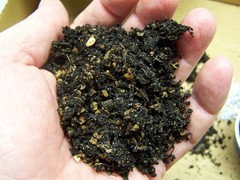
Good stuff ........
Alkimbearlee
8 years agolast modified: 8 years agoThanks everyone for your input I am feeling more hopeful and I am seeing the starts of plants poking up through the soil. Joe, yes the bottom is open and in full contact with the native soil. I choose this type of gardening as I have not had much success with planting directly in the ground. I have a somewhat high content of clay in the soil in my yard. We did loosely break up the ground underneath and mixed the native soil with topsoil before adding the gardening soil. I plan on composting this year and changing my soil mixture next year.
drew51 SE MI Z5b/6a
8 years agolast modified: 8 years agoMy compost is mixed in peat, not sand and I live in MI, You get what you pay for. I would never use topsoil in pots, or at all, especially raised beds. It's junk soil, no thanks!
gardengal48 (PNW Z8/9)
8 years agoI probably shouldn't even ask this, cuz I know I'm going to get some weird answer, but why is topsoil 'junk soil'? And why do you think it shouldn't be used in raised beds?
gardengal48 (PNW Z8/9)
8 years agopip, my question was directed at the last poster before mine, who is inclined to make some strong and generally unsupported statements :-) I am very familiar with the thread and its concepts but bottomless raised bed gardening is NOT the same as container gardening and is not governed by the same critical conditions of drainage and aeration as are containers. 'Topsoil' or regular garden soil is a completely acceptable ingredient in a raised bed soil mix. In fact, a mineral-based soil - real garden soil or topsoil - can be argued to be an essential ingredient in this type of mix, providing a range of micronutrients and trace elements that are usually missing from any sort of soil-less mix.
A bottomless raised bed is just the same as a regular inground garden bed except that it has raised, and often solid, sides. Typically, these types of planting beds are filled with same sort of products you would use to amend any other inground planting area - plain ole 'dirt' and the array of organic matter one prefers.drew51 SE MI Z5b/6a
8 years agolast modified: 8 years agoBeing a scientist, i hate when people post with no data to backup what they say. I know I always have numerous studies to support my positions. I only advocate what I know, and have done numerous times. Well for the last 40 years anyway. Experience always wins.
Real topsoil is great, but what they sell as topsoil is anything but.
When you live in an old growth forest like I do, you know what real topsoil looks like. My raised beds have no topsoil whatsoever in them

Container culture? Sure, I do that too!
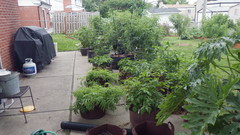
At my cottage I'm in the middle of an old growth forest. I have had the place for 50 years.

drew51 SE MI Z5b/6a
8 years agoThe reason i say topsoil is junk is it is not a legal term. I can sell sand and call it topsoil. It's where all the leftovers go. The compost with herbicides, the scraped subdivision soil mixed with clay. Rotted pallets, you name it, it has been found in topsoil.
I myself have found wiring, plastic, nails, you name it! Lot's of rocks too.
If you have to fill a raised bed I suggest garden soil which is usually a mix of compost and topsoil. Often compost is in a humus soil, add peat, pine bark soil conditioner, old potting soil, DE. Keep adding leaves, and compost every year. I add leaves in the fall that are super shredded. I use any left in the spring as a mulch.
If you use topsoil, try and know where it come from and what is in it. Same with any soil, compost, garden soil etc.
The previous photos were from last summer. I just went out today and took some shots
Garlic with peppers behind them. No topsoil

This is zone 5b and my peppers were just put out, but producing even at a young age.

Here is one of many strawberry patches I have. Summer bearing in front, pineberries, and musk strawberries in back. No topsoil.
Onions in the front bed, strawberries, surrounding a blueberry plant in the center. The back bed is raspberries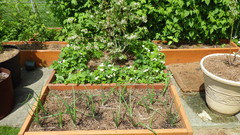
This front bed has a few onions and radishes. A melon is going in that spot soon. Germinating seeds now. The middle bed again is strawberries surrounding a blueberry plant. and more of the 24 foot long raspberry bed in the back. No topsoil.
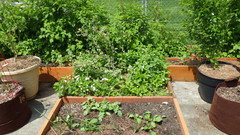
Yet another this time tomatoes in the front. Blueberries and strawberries back by the long raspberry bed. No topsoil.

gardengal48 (PNW Z8/9)
8 years ago"Being a scientist, i hate when people post with no data to backup what
they say. I know I always have numerous studies to support my positions.
I only advocate what I know, and have done numerous times. Well for the
last 40 years anyway. Experience always wins."
Then as a scientist perhaps you should post or make reference to some of the 'numerous studies' and data that support your contentions. And experience doesn't always win......experience can be good or bad - or most often - simply mediocre.
"Real topsoil is great, but what they sell as topsoil is anything but."
And as a scientist, you should be well aware of the hazards in making blanket generalizations like that. How do you know what's being sold in my area as "topsoil"?? The definition of 'topsoil' is just the top level (usually 5" is the measure provided but it can be deeper) of the soil profile before any construction or cultivation takes place. During current development/construction practices, the top layer of soil - "topsoil" - is scraped off, carted away and most often sold. As with any naturally occurring soil, the quality, texture and fertility can vary widely. Sometimes it gets amalgamated with other materials before being bagged and sold - sometimes not. If offered by a bulk soil provider, it is usually just the straight stuff - rocks, roots and all (although it is also often screened to remove large debris). Depending on who is marketing the product, it can be just fine.
Regardless, a mineral-based soil, labeled topsoil or not, is a recommended addition to any bottomless raised bed garden.waterbug_guy
8 years agoYes, absolutely soil X is the best soil for everyone as long as everyone lives next door to you.
Unfortunately the world is a bit bigger. I've gardened in NY, FL, TX, CA, AK, AZ and Germany. In hot dry climates like AZ and TX those nice fluffy well draining soils are great as long as you water a several times a day and stay in shade. 110F and 6% humidity is not the same as 80F and 70% humidity. In these climates even top soil isn't dense enough, I use a mix of our top soil which is heavy clay AND mix in what we call adobe clay, some plants just adobe. Yeah, takes 10-60 minutes for water sitting on the surface to drain down. That's good because it also means water is very slow to be drawn out and the clay holds more water.
Many plants I grow in pots with zero drainage. Plants like tomatoes which are known to grow in water, but also more desert type plants like mesquite and other trees which people say absolutely have to have great drainage. The only requirement seems to be no standing water for a long time. Wet feet are fine, but as the water level approaches the soil level the plant can start to have trouble. Lots of good healthy roots absolutely grow at the bottom of the bucket, almost always submerged.
An interesting thing I saw is when a plant dies in a no drainage pot is it slows/stops transpiration as it dies and the soil surface stays wet for a much longer period, starts to look yucky, algae may form. 99.9% gardeners looking at it would probably say "died from over watering". It's a knee jerk learned response. Why didn't 10 other plants, same kind, same soil, same water, same sun also die? Went on growing for years? I think it's because plants can actually die from more than just over watering. But you wouldn't know that talking to many gardeners.
Most will think I'm a troll, a cretan, a malcontent, etc... because my experience is different from yours. That's cool, I am a contrarian gardener. I'm weird, I try stuff. You can too.tapla (mid-Michigan, USDA z5b-6a)
8 years agoA huge % of the people arriving at this and other container-related forums are here because their soils hold too much water. It can't be denied that a perched water table is very limiting unless the plant has adapted to some form of aqua culture. Soggy soils are anything but ideal, and those moving toward elimination of muddy soils have enthusiastically used their voice to indicate the increase in rewards for effort expended is welcome, indeed.
The whole topsoil thing started because someone painted the use of 'topsoil' in a raised bed with a brush much too wide and got called on it, and rightly so. You can't ASSUME your topsoil order is going to be junk and then build a case on the assumption. I just had some landscaping done, and there was about 10 yards of topsoil as part of the work. It was excellent material, and I wouldn't hesitate for a second to use it as a significant fraction (60-85%) of a soil for raised beds. As Pam noted, the mineral fraction has to come from SOMEWHERE, and a good to middling topsoil provides an excellent base to build on.
Al
UnbalancedHangerOuter
8 years agoYou know, all of you are quite arrogant and rude to people who just want to learn. You may not all mean it, but the following statements are SO condescending that I hate trying to find an answer on this forum: "Being a scientist, I hate...", "It can't be denied that...", and "The idea of trying for no more than mediocre results doesn't make much sense." I doubt that anyone comes here with the intention of doing a crappy job. When you criticize or denigrate how someone is gardening, you are the one who looks like a jerk to the rest of us. Maybe you don't realize you're talking down AT us instead of having an adult discussion with us. If you don't, try reading your posts before hitting submit and see if you would like someone else saying it to you. If you just posted your comments from the first person point of view, you would come across as much more helpful and less confrontational. "Being a scientist, I hate..." just comes across as bragging and condescending - I can't fix that statement to make it inviting. "It can't be denied that a perched water table is very limiting unless the plant has adapted to some form of aqua culture." First of all, that is the horrible passive voice that we are all supposed to avoid. It would come across as friendlier if you said, "Unless the plant has adapted to some form of aqua culture, a perched water table is very limiting in my opinion." "The idea of trying for no more than mediocre results doesn't make much sense." This statement would be so much more inviting if you just emphasize that you try to do your best. Going on and on about how you try your best is, again, bragging. I've looked at Container Soils, Ficus Pruning, Vegetable Gardening, and many other sections of this forum and you all sound like a bunch of blowhards even though I do learn things hidden deep within the pontification.
Now, I guess I will get kicked off this site, and you won't have to worry about me lurking and judging you like you judge others.Ann, Tennessee Zone 7A
mblan13
8 years ago"I only advocate what I know, and have done numerous times. Well for the last 40 years anyway. Experience always wins."
So if someone knows more than you and does it better than you, it's invalid because YOU haven't personally done it, or experienced it?
Doesn't sound very "scientist-y" to me.
P.S. I live in the fertile Susquehanna river valley of Pennsylvania, our "topsoil" is spectacular!
tapla (mid-Michigan, USDA z5b-6a)
8 years agolast modified: 8 years ago...... can't/won't argue with you there.
I'm still wondering why we should state facts as though they are opinions - to soften the blow and make them sound friendlier ..... like it's somehow improper to simply state a fact? Most facts can be stated in ways that make qualification unnecessary; but when qualification IS necessary, you can learn a LOT about whether the person making the statements is operating at beyond the limits of his/her knowledge by noting the lack of or erroneous qualification.There is little question that taking most of the thread's participants to task for their perceived pontification, is in fact .......... pontification. Most of us come here to help others by sharing our knowledge and experiences, sometimes in a straightforward manner and using as few words as possible - hand-holding is optional.
Al








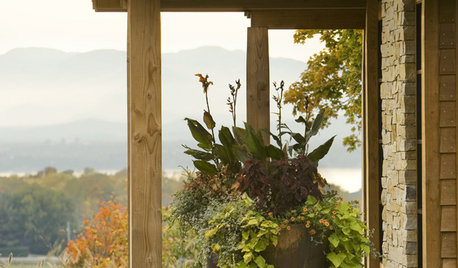










tapla (mid-Michigan, USDA z5b-6a)